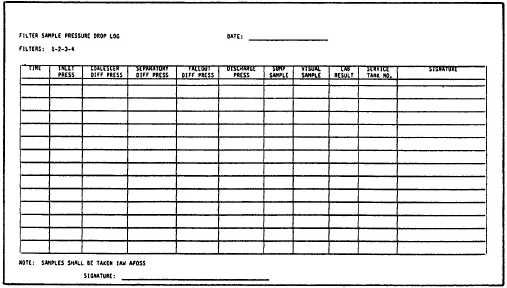maintenance project cards of the ship. Any other
operational data that could be useful at a future date
should be recorded. A daily inspection of the fuel
system should be made for leaks and other
discrepancies and recorded in the log.
The maintenance logbook should contain all
work performed on the aviation fuels systems by the
repair crews. It should be recorded in a day-to-day
order.
Other logbooks required to be kept are the
following:
Fuels security watch log.
Filter sample/pressure drop log (fig. 8-4).
Quality surveillance sample log.
Equipment running logs (fig. 8-5). Each piece
of equipment should have its own log, such
as service pump #2. transfer pump #1,
purifier #3.
Stripping logs.
All logbooks should be inspected frequently by
appropriate petty officers, the work center chief, and
the division officer. Often, the information contained
in a log may indicate the impending failure of a piece
of equipment long before the actual failure occurs.
Checklists
Checklists (fig. 8-6) provide a minimum written
list of items for inspection. Checklists are typically
tailored to fit specific equipment or operations and
can cover everything from a pre-operational check on
a fuel truck to inspecting the entire fuel system after
an underway replenishment.
The advantage of using a checklist is obvious.
With the items to be inspected written, you are less
likely to miss a step or procedure. If you use
checklists, make sure all PMS requirements are met.
Aircraft Checker Reports
One of the major problems encountered by senior
ABFs in operating an aviation fuels system is keeping
accurate records of fuel expenditures. The measuring
instruments (meters, liquid-level indicators, sounding
tapes) are not sufficiently accurate for use in comput-
ing fuel expenditure for a particular aircraft or
squadron.
The most accurate way of computing the amount
of fuel issued to a particular aircraft is with the use of
the aircraft’s fuel gages. At the time of arrestment, by
subtracting the fuel load from the total capacity of the
aircraft’s fuel tanks, you can determine how much
fuel is needed to top off the tanks. The aircraft’s fuel
gages are calibrated in pounds of fuel, and a
conversion must be made to convert the pounds of
fuel issued to gallons.
Fuel checkers are assigned the duty of keeping
an account of all fuels issued to or taken from an
aircraft.
Checker cards are useful for this purpose. These
cards (or sheets) should have places for the date and
the checker’s name at the top. There should be spaces
Figure 8-4.—Example of a fuel sample/pressure drop log.
8-4

